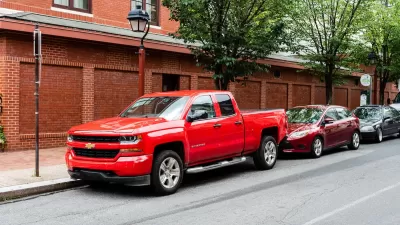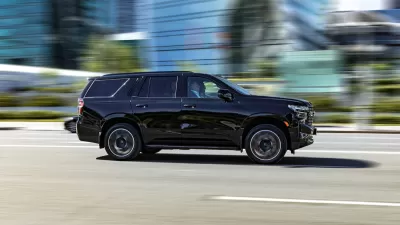On the heels of research showing that SUV design is leading to more pedestrian deaths, another IIHS study shows a higher rate of serious injuries for cyclists hit by taller vehicles.

A new study from the Insurance Institute for Highway Safety (IIHS) and the Highway Loss Data Institute (HLDI) reveals that taller SUVs are causing more severe injuries when they hit people on bikes. “The findings follow earlier IIHS research that showed SUVs are more lethal than cars to pedestrians despite design changes that have made them less dangerous to other vehicles.”
According to IIHS Statistician Sam Monfort, “SUVs tend to knock riders down, where they can also be run over, rather than vaulting them onto the hood of the vehicle.” Between 2010 and 2020, the number of bicyclists killed on U.S. roads went up from 621 to 932. “One reason may be the dominance of pickups and SUVs in the U.S. vehicle fleet.” According to an assessment made using the Abbreviated Injury Scale, “the average scores for head injuries inflicted by SUVs were 63 percent higher than for those caused by cars.”
The results of the study “suggest that SUVs forcefully knock bicyclists to the ground, where they can be run over by the vehicle as the driver attempts to stop. Even when the bicyclist is not run over, SUV crashes are much more likely than car crashes to result in injuries caused by the bicyclist hitting the ground.”
FULL STORY: Higher point of impact makes SUV crashes more dangerous for cyclists

Maui's Vacation Rental Debate Turns Ugly
Verbal attacks, misinformation campaigns and fistfights plague a high-stakes debate to convert thousands of vacation rentals into long-term housing.

Planetizen Federal Action Tracker
A weekly monitor of how Trump’s orders and actions are impacting planners and planning in America.

In Urban Planning, AI Prompting Could be the New Design Thinking
Creativity has long been key to great urban design. What if we see AI as our new creative partner?

King County Supportive Housing Program Offers Hope for Unhoused Residents
The county is taking a ‘Housing First’ approach that prioritizes getting people into housing, then offering wraparound supportive services.

Researchers Use AI to Get Clearer Picture of US Housing
Analysts are using artificial intelligence to supercharge their research by allowing them to comb through data faster. Though these AI tools can be error prone, they save time and housing researchers are optimistic about the future.

Making Shared Micromobility More Inclusive
Cities and shared mobility system operators can do more to include people with disabilities in planning and operations, per a new report.
Urban Design for Planners 1: Software Tools
This six-course series explores essential urban design concepts using open source software and equips planners with the tools they need to participate fully in the urban design process.
Planning for Universal Design
Learn the tools for implementing Universal Design in planning regulations.
planning NEXT
Appalachian Highlands Housing Partners
Mpact (founded as Rail~Volution)
City of Camden Redevelopment Agency
City of Astoria
City of Portland
City of Laramie





























